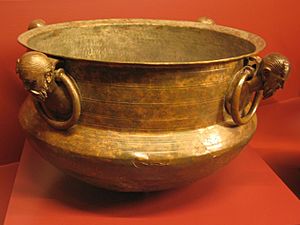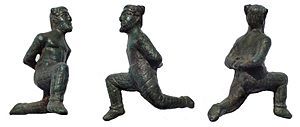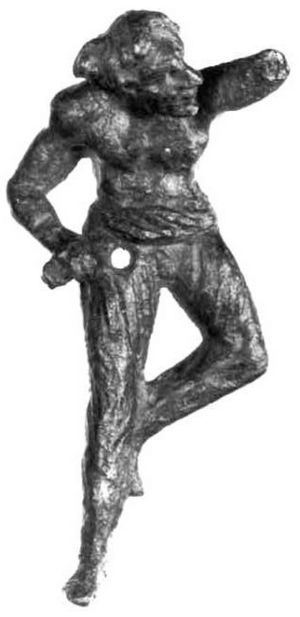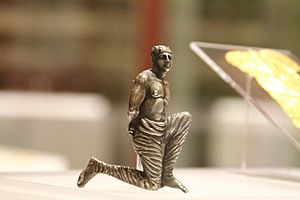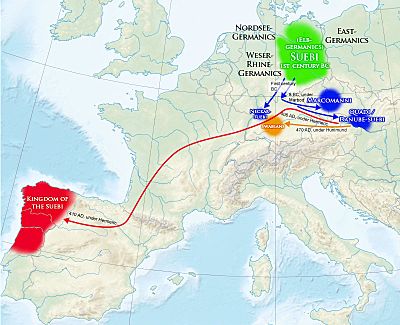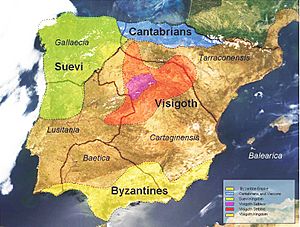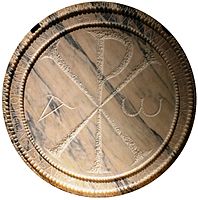Suebi facts for kids
The Suebi (say "SWEE-bee") were a big group of Germanic peoples who originally lived near the Elbe river. This area is now part of Germany and the Czech Republic. In early Roman era times, this group included many smaller peoples. Some of these were the Marcomanni, Quadi, Hermunduri, Semnones, and Lombards.
Later, new groups like the Alamanni and Bavarians formed. During the Migration Period, two kingdoms were simply called Suebian. Even though the Roman writer Tacitus said the Suebi were not one old tribe, another writer, Pliny the Elder, linked them to the Irminones. This was another group of Germanic peoples who believed they shared ancestors. Tacitus also wrote about Suebian languages and a place called "Suevia."
The Suebi were first mentioned by Julius Caesar. This was when the Germanic king Ariovistus invaded Gaul during the Gallic Wars. Caesar saw the Suebi as a single people. He thought they were a growing danger to Gaul and Italy. They had been moving south, taking land from Gallic tribes. They were setting up a Germanic presence north of the Danube river. Caesar believed the Suebi were the most warlike of the Germanic peoples.
During the time of Augustus, the first Roman emperor, Rome fought many wars in Germania. This was east of the Rhine and north of the Danube, pushing towards the Elbe. After a big defeat by the Romans in 9 BC, Maroboduus became king of a Suebian kingdom. This kingdom was safe within the mountains and forests of Bohemia. The Suebi did not join the alliance led by Arminius.
In 69 AD, the Suebian kings Italicus and Sido helped the Roman leader Vespasian.
Under Emperor Marcus Aurelius in the 2nd century AD, the Marcomanni invaded Italy. They might have been pushed by East Germanic tribes from the north.
By the Crisis of the Third Century, new Suebian groups appeared. The Juthungi invaded Italy again. The Alamanni attacked Gaul and settled in the Agri Decumates. The Alamanni kept putting pressure on Gaul. An Alamannic leader named Chrocus helped Constantine the Great become Roman emperor.
By the late 4th century AD, many Gothic and other eastern peoples moved into the Middle Danubian area. This area was home to the Quadi and Marcomanni. These people were escaping problems caused by the Huns. In 406 AD, Suebian tribes led by Hermeric, along with Alans and Vandals, crossed the Rhine. They took over Gaul and Hispania. They eventually created the Kingdom of the Suebi in Galicia.
After the Huns lost power in the Battle of Nedao, there was also a short-lived Suebian kingdom on the Danube. This was led by Hunimund. They were defeated by the Ostrogoths. In the sixth century, the Suevic Longobards moved from the Elbe. They became a major power in the Middle Danube.
During the last years of the decline of the Western Roman Empire, a Suebian general named Ricimer was the real ruler. The Lombards, along with many other peoples, later settled Italy. They established the Kingdom of the Lombards.
The Alamanni, Bavarii, and Thuringii stayed in Germania. They gave their names to the German regions of Swabia, Bavaria, and Thuringia. Suebian languages are thought to be a main source of later High German languages. These include the dialects spoken in Southern Germany, Switzerland, and Austria.
Contents
What Does "Suebi" Mean?
Experts believe the name "Suebi" comes from an old Germanic word. It means "one's own" people. This is like saying "our people."
Other group names, like the Suiones (from which "Swedes" comes), also seem to come from this same root. This suggests there might have been a very old, common name for "our own people" in Indo-European languages.
Some people think the name might also come from a Celtic word for "traveler" or "wanderer."
Who Were the Suebi?
More Than One Tribe
Julius Caesar first described the Suebi as a single, powerful Germanic tribe. He placed them east of the Ubii, near what is now Hesse. However, later writers like Tacitus and Pliny the Elder said that the Suebi were not just one group. They were a large collection of different tribes. These tribes lived across more than half of Germania. They had their own names but were all generally called Suebi.
For example, Tacitus said the Suebi were different from the Chatti. The Chatti were more settled in one place, while the Suebi moved around more. At one point, the name Suevi was used for so many Germanic tribes that it seemed like it might replace the name "Germans."
Modern historians use the term "Elbe Germanic" for many of these groups. This term helps describe the ancient peoples who spoke the dialects that led to today's Upper German dialects. These are spoken in Austria, Bavaria, Thuringia, and parts of Switzerland.
Tribes Near the Danube
In Caesar's time, southern Germany had a mix of Celtic and Germanic tribes. Germanic groups, led by the Suebi, were putting pressure on them. Later, Tacitus said that southern Germany, between the Danube, Main, and Rhine, had been left empty by two large Celtic groups. These were the Helvetii and the Boii.
Strabo also linked the Suebi to the Hercynian Forest and southern Germany, north of the Danube. He mentioned Suevic peoples like the Marcomanni. Under King Marobodus, they moved into the Hercynian forest. They took over an area called "Boihaemum," which was named after the Celtic Boii.
Tacitus described several strong Suebian states along the northern Danube. This river was the border with Rome. From west to east, these included the Hermunduri, Naristi, Marcomanni, and Quadi. The Quadi were on the edge of greater Suebia, next to the Sarmatians.
Tribes Near the Rhine
Caesar said the Suebi were pushing Germanic tribes like the Tencteri, Usipetes, and Ubii from the east. This forced them out of their homes near the Rhine. He described the Suebi as warlike.
Strabo wrote that the Suebi were the most powerful and numerous. He said Suebic peoples had come to rule Germany between the Rhine and Elbe. The only exceptions were the Rhine valley and the northern coastal areas.
The geographer Ptolemy (around 90-168 AD) mentioned Suebi between the Rhine and the Elbe. He described them stretching from the Elbe all the way to the northern Rhine. He placed the "Suevi Langobardi" closest to the Rhine.
In the third century, a large group of Suebi, also called the Allemanni, moved to the Rhine bank. This area, now called Schwaben, had been controlled by the Romans.
Tribes Near the Elbe
Strabo didn't say much about the Suebi east of the Elbe. He said this area was mostly unknown to Romans. But he did mention that some Suebi lived there, including the Hermunduri and Langobardi.
From Tacitus and Ptolemy, we get more details:
- The Semnones were called "the oldest and noblest of the Suebi" by Tacitus. They had 100 districts. Tacitus said their large size made them feel like the leaders of the Suevic people. Ptolemy placed the "Suevi Semnones" on the Elbe.
- The Langobardi lived further from Rome's borders. Tacitus said they were few in number but safe because they were brave in war.
- Tacitus also named seven tribes who lived "next" to the Langobardi. These tribes worshiped Nertha, or Mother Earth.
How They Lived
Caesar noted that the Suebi focused on raising animals and hunting, not growing many crops. They wore animal skins and bathed in rivers. They ate milk and meat products and did not drink wine. They only traded to sell things they had taken in war. They did not own land privately and could not stay in one place for more than a year. They were divided into 100 groups, each providing 1000 armed men for constant warfare.
Strabo described the Suebi as very mobile and nomadic. They were different from more settled tribes like the Chatti. He said they did not farm or store food. They lived in small, temporary huts. They mostly lived off their animals, like nomads. They would load their belongings onto wagons and move wherever they thought best.
A special thing about the Suebi was their unique hairstyle, called the "Suebian knot." This hairstyle showed if a man was free or a slave. Chiefs wore an even fancier version.
Tacitus mentioned that the Semnones sacrificed humans in a sacred grove. Other tribes used slaves in their religious ceremonies.
Their Language
The Suebi are generally believed to have spoken one or more Germanic languages. Tacitus mentioned "Suebian languages," suggesting there was more than one. The Suebi are linked to the "Elbe Germanic" group of early dialects. These dialects came from the east and started near the Baltic Sea. Later, these dialects, spoken south of the Elbe, changed. This change led to modern High German languages, especially the Upper German dialects.
Modern Swabian German and Alemannic German are thought to have come from Suebian. Bavarian, the Thuringian dialect, and even standard "High German" are also partly from Suebian dialects.

Key Historical Events
Ariovistus and the Suebi (58 BC)
Julius Caesar described the Suebi as the "largest and the most warlike nation of all the Germans." In 58 BC, Caesar faced a large army led by a Suevic king named Ariovistus. Ariovistus had already settled in Gaul. He had been invited by the Gaulish Arverni and Sequani to help them fight the Aedui. Ariovistus told the Romans not to enter Gaul. But Caesar saw Rome as a helper of the Aedui.
Ariovistus's army included the Harudes, Marcomanni, and Suebi. While Caesar was getting ready, a new group of Suebi arrived at the Rhine. Caesar quickly defeated Ariovistus, forcing him to flee across the Rhine. When this news spread, the new Suebian forces panicked and turned back. Local tribes along the Rhine then attacked them.
Caesar and the Suebi (55 BC)
In 55 BC, the Suebi caused another problem. The Germanic Ubii, who were allies with Caesar, complained that the Suebi were bothering them. The Tencteri and Usipetes, forced from their homes, tried to cross the Rhine into Gaul. Caesar built a bridge over the Rhine, which was a big achievement. He used it to cross and warn the Suebi. The Suebi then stopped bothering the Ubii. The Ubii later moved to the west bank of the Rhine, into Roman land.
Roman Victories and Defeats
In 9 BC, the Suebi were defeated by Nero Claudius Drusus. He pushed many Germans to the other side of the Elbe river. After this defeat, the Romans made peace with Maroboduus. He was described as king of the Suevians, though he was often called king of the Marcomanni. His kingdom was in Bohemia.
In 6 AD, Emperor Augustus planned to destroy Maroboduus's kingdom. But a revolt in Illyria forced the Romans to make a treaty with Maroboduus.
Battle of the Teutoburg Forest (9 AD)
After Drusus died, the Cherusci destroyed three Roman legions in the Battle of Teutoburg Forest. The Roman Empire's expansion stopped at the Rhine. While some Suebi might have been involved, this battle was mainly fought by other Germanic tribes. Maroboduus and his allies, including some Suebic peoples like the Hermunduri and Langobards, stayed out of the fight.
After this, Germanicus, Drusus's son, took charge of the Roman forces. He fought the Cherusci and their allies. He broke their power at the battle of Idistavisus. Later, Arminius, the Cherusci leader, fought Maroboduus. The Suebic Semnones and Langobardi rebelled against Maroboduus and joined Arminius. Maroboduus eventually fled to Ravenna and died there in 37 AD.
Marcomannic Wars (2nd Century AD)
In the 2nd century AD, the Marcomanni joined with other peoples like the Quadi and Vandals. They fought against the Roman Empire. The war started in 166 AD. The Marcomanni broke through Roman defenses and reached close to Aquileia on the Adriatic sea. The war lasted until Emperor Marcus Aurelius died in 180 AD.
Moving and Settling (Migration Period)
In 259/260 AD, groups of Suebi helped form a new alliance called the Alemanni. They moved into the Roman border region called the Agri Decumates. This area is east of the Rhine. The Alamanni were sometimes just called Suebi. The region became known as Swabia, a name still used today. People from this part of Germany are still called Schwaben, which comes from the Suebi.
Most of these Suebi stayed on the east bank of the Rhine until December 31, 406 AD. On that day, many of them joined the Vandals and Alans. They crossed the Rhine, possibly at Mainz, and invaded northern Gaul. This group likely included many Quadi.
Other Suebi stayed in their original homelands near the Elbe. They later expanded into Roman areas like Switzerland, Austria, and Bavaria.
Further south, a group of Suebi settled in parts of Pannonia. This was after the Huns were defeated in 454 AD. Later, the Suebian king Hunimund fought the Ostrogoths. The Suebian alliance lost, and some Suebi moved to southern Germany. The Lombards, a Suebic group, later ruled the Pannonian region before invading Italy.
Another group, the "northern Suebi," were mentioned in 569 AD. They lived in areas of today's Saxony-Anhalt.
The Suebian Kingdom in Gallaecia
Moving to Hispania
Suebi, led by king Hermeric, probably from the Alemanni or Quadi, moved through southern France. They crossed the Pyrenees mountains and entered the Iberian Peninsula. This area was no longer under Roman rule.
They settled in the Roman province of Gallaecia, in northwestern Hispania. This is modern Galicia, Asturias, and northern Portugal. They promised loyalty to Emperor Honorius. They were allowed to settle as foederati, meaning allies with their own rule. The Suebian kingdom in Gallaecia became the first kingdom to form as the Western Roman Empire fell apart. It was also the first kingdom separated from Rome to make its own coins.
The Suebian kingdom in Gallaecia lasted from 410 to 584 AD. It was smaller than other kingdoms but became stable and rich. It even expanded south, despite occasional fights with the nearby Visigothic kingdom.
How They Settled
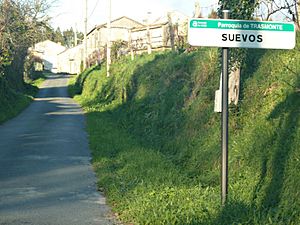

The Germanic invaders mostly settled in the countryside. The local people lived in cities. The Suebi quickly learned the local language. Few traces of their Germanic language remained, except for some words and personal names. In Galicia, several villages are still named Suevos or Suegos, meaning Sueves, after old Suebic settlements.
Bracara Augusta, now Braga, became the Suebian capital. Another Germanic group, the Buri, also settled in Gallaecia. They lived between the Cávado and Homem rivers in Portugal.
Kingdom's Growth and Challenges
In 416 AD, the Visigoths were sent by Emperor Honorius to fight the Germanic invaders in Hispania. After the Vandals left for Africa in 429 AD, the Suebi were able to expand. They took the Roman capital, Mérida, in 439 AD.
In 438 AD, King Hermeric made peace with the local people. He then gave up his throne to his son Rechila. Rechila was a great general. He defeated Roman military leaders. In 448 AD, Rechila died, and his son Rechiar became king. Rechiar became a Catholic around 447 AD. He married the daughter of the Gothic king Theodoric I. He then began attacking the Roman province of Tarraconense.
By 456 AD, Rechiar's actions clashed with the Visigoths. A large army of Visigoths and Burgundians defeated the Suebi near Astorga. Rechiar was captured and killed. In 459 AD, the Roman emperor Majorian defeated the Suebi again. But after Majorian was killed, the Suebi became free of Roman control forever.
After some chaos, Remismund became the sole king of the Suebi. He made friends with the Visigoths. He also encouraged his people to become Arian Christians.
Final Years of the Kingdom
In 561 AD, King Ariamir held the First Council of Braga for Catholic bishops. In 569 AD, King Theodemir held the First Council of Lugo to create more church areas.
Defeat by the Visigoths
In 570 AD, the Arian Visigothic king, Leovigild, attacked the Suebi. Between 572 and 574 AD, Leovigild pushed the Suebi west and north. In 575 AD, the Suebic king, Miro, made a peace treaty with Leovigild.
However, in 583 AD, Miro supported a rebellion by a Catholic Gothic prince. Miro was defeated by Leovigild. He was forced to accept Leovigild as a protector. Miro died a few months later. His son, King Eboric, confirmed the friendship with Leovigild. But Eboric was removed from power by his brother-in-law Audeca a year later. This gave Leovigild an excuse to attack the kingdom.
In 585 AD, Audeca and later Malaric were defeated. The Suebic kingdom became part of the Visigothic kingdom. The Suebi were allowed to keep their property and freedom. They continued to live in Gallaecia and eventually mixed with the local population.
Religion and Conversion
Becoming Arian Christians
The Suebi were mostly pagan (worshiping many gods). Their subjects followed a different Christian belief called Priscillianism. Then, an Arian missionary named Ajax came. He was sent by the Visigothic king Theodoric II. In 466 AD, Ajax converted the Suebi. He set up a lasting Arian church. This church was important until they converted to Trinitarian Catholicism in the 560s.
Becoming Catholic Christians
There are different stories about how the Suebi became Catholic Christians:
- The records of the First Council of Braga (561 AD) say King Ariamir ordered the meeting. He was a Catholic king.
- The Historia Suevorum says King Theodemar converted his people with the help of Martin of Dumio.
- The Frankish historian Gregory of Tours said an unknown king named Chararic promised to become Catholic if his son was cured of leprosy. His son was healed, and Chararic and his family converted.
- By 589 AD, when the Third Council of Toledo was held, the Visigothic Kingdom officially became Catholic. King Reccared I said that "an infinite number of Suebi have converted" too. This suggests their earlier conversion was not complete.
Most historians try to combine these stories. It's believed the conversion was a gradual process.
Suebi in Norse Mythology
The name Suebi also appears in Norse mythology and old Scandinavian writings. For example, the name Swabaharjaz ("Suebian warrior") is found on a runestone. Also, Sváfa, whose name means "Suebian," was a Valkyrie in a Norse poem. A kingdom called Sváfaland also appears in these stories.
See also
 In Spanish: Pueblo suevo para niños
In Spanish: Pueblo suevo para niños
- Swabia
- Dukes of Swabia family tree
- Germanic personal names in Galicia
- Laeti


